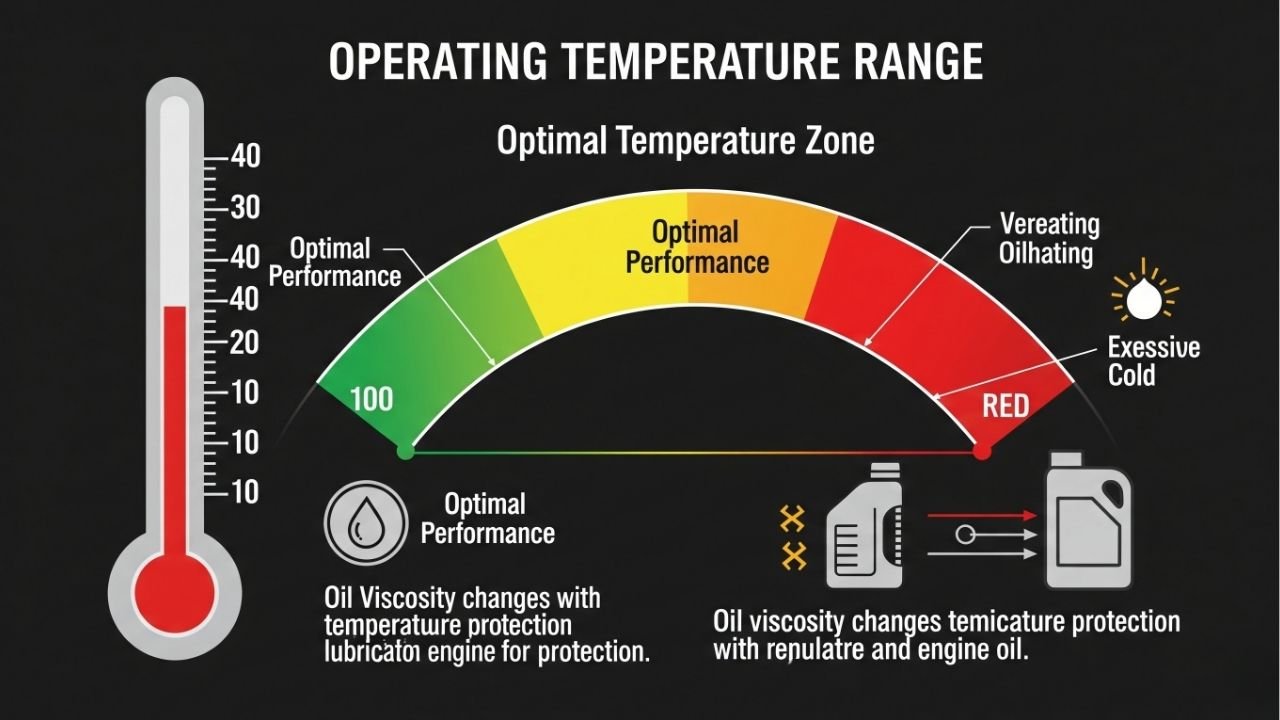Understanding Car Oil Operating Temperature

Have you ever wondered what happens under the hood once you start your car? I’m not talking about the engine noise or dashboard lights—I mean the invisible stuff that keeps the engine alive. One of the most overlooked yet vital elements is your car oil operating temperature. It’s the “Goldilocks zone” for your engine oil—not too cold, not too hot, but just right.
I remember one winter morning in Dhaka when I started my car after it sat outside all night. The engine felt sluggish. Later, I found out the oil hadn’t warmed up enough. That was a lesson I won’t forget! And trust me, this matters just as much during a scorching summer drive through Chattogram. The right oil temperature can mean the difference between smooth sailing and expensive engine damage.
In this article, we’ll dive deep into what car oil operating temperature really is, why it matters, how to measure it, and how to manage it across different climates and driving habits. All this, in simple, easy-to-read language that makes the topic accessible to every car owner—whether you’re a gearhead or just learning the ropes.
In This Article
- 1 The Basics: What Is Car Oil Operating Temperature?
- 2 Why Oil Temperature Is the Lifeline of Engine Performance
- 3 How to Measure Car Oil Operating Temperature: Simple and Smart
- 4 Climate and Driving Style: Hidden Influencers of Oil Temperature
- 5 Effects of Running Too Cold or Too Hot: Don’t Ignore These Signs
- 6 Common Causes of Abnormal Oil Temperatures
- 7 Tips to Maintain Healthy Car Oil Operating Temperature
- 8 Real-Life Experiences: When I Ignored Oil Temperature and Paid the Price
- 9 Best Oils for Managing High and Low Operating Temperatures
- 10 Myths and Misconceptions About Oil Temperature
- 11 Bullet Recap: What You Should Remember
- 12 FAQs About Car Oil Operating Temperature
- 13 Conclusion: Your Engine’s Best Friend Deserves More Attention
The Basics: What Is Car Oil Operating Temperature?

Here’s why this temperature range matters:
-
Too cold: The oil becomes thick and sluggish. It doesn’t move fast enough to protect vital engine parts.
-
Too hot: The oil thins out and loses its ability to cushion metal surfaces, which leads to wear and tear.
Think of it like cooking oil. When it’s cold, it clumps and sticks; when it’s too hot, it smokes and breaks down. Your engine oil behaves the same way.
Pro Tip: Always wait a few minutes before revving a cold engine. Letting the oil heat up can prevent long-term engine damage.
Why Oil Temperature Is the Lifeline of Engine Performance
Your engine is full of moving metal parts. Without proper lubrication, they grind against each other—causing friction, heat, and damage. But the magic of motor oil lies in its ability to create a barrier between those parts.
Now here’s the catch: this magic only happens if the oil is within the correct operating temperature.
If your car oil operating temperature is too low, the oil is too thick to flow into tight spots. On the flip side, if it’s too high, it turns into a watery mess and can’t protect engine components.
Also, oil doesn’t just lubricate—it:
-
Cools the engine by absorbing heat
-
Cleans internal parts by capturing sludge and debris
-
Protects from corrosion
But none of this works if the temperature isn’t right. So, yes, oil temperature is not just about numbers—it’s about life or death for your engine.
How to Measure Car Oil Operating Temperature: Simple and Smart
Modern cars often come with sensors that monitor engine oil temperature. You might find this data on the dashboard or infotainment screen. But if your car doesn’t show it, there are two common ways to measure it:
-
Aftermarket Gauges
These plug into your car’s OBD-II port and show real-time temperature readings. They’re easy to install and super handy. -
Infrared Thermometers
If you’re into DIY, an IR thermometer can help you check oil temp near the oil filter or pan. Not 100% accurate, but close enough for casual checks.
Normal operating ranges (in Fahrenheit and Celsius):
| Driving Condition | Normal Oil Temp (°F) | Normal Oil Temp (°C) |
|---|---|---|
| City driving | 195°F – 210°F | 90°C – 99°C |
| Highway driving | 210°F – 220°F | 99°C – 105°C |
| Aggressive driving | 220°F – 250°F | 105°C – 121°C |
| Racing / Towing | 250°F – 300°F | 121°C – 149°C |
Note: Temperatures above 260°F (127°C) are dangerous unless you’re driving a performance vehicle designed for high heat.
Climate and Driving Style: Hidden Influencers of Oil Temperature
Let me tell you a little story. During one of my trips to Sylhet in the rainy season, my engine ran much cooler than usual. That’s because ambient temperatures can hugely influence your car oil operating temperature.
Here’s how different conditions affect it:
-
Cold Weather: Oil takes longer to heat up. Short trips might never let it reach its optimal range, leading to sludge buildup over time.
-
Hot Weather: The engine warms up fast. But if you’re idling in traffic, airflow drops, making oil temperature spike.
-
Aggressive Driving: Pushing the pedal, frequent acceleration, or towing raises engine load—and in turn, the oil temp.
-
Stop-and-Go Traffic: Even without high speeds, heat builds up due to reduced cooling.
So, whether you’re stuck on the Dhaka-Mawa Expressway or cruising the hills of Bandarban, your driving environment shapes your oil’s behavior.
Effects of Running Too Cold or Too Hot: Don’t Ignore These Signs
Ignoring your car oil operating temperature is like ignoring your own body temperature during a fever—dangerous and potentially fatal. Here’s what can go wrong:
When It’s Too Hot:
-
Oil breaks down chemically
-
Lubrication fails
-
Increased wear on engine parts
-
Risk of engine seizure
-
Higher fuel consumption
When It’s Too Cold:
-
Poor fuel efficiency
-
Increased engine wear
-
Sludge formation
-
Delayed oil flow to engine parts
It’s a delicate balance—just like cooking biryani. Too much heat, and it burns. Too little, and it’s undercooked. Your car engine, believe it or not, is just as picky.
Common Causes of Abnormal Oil Temperatures
If your oil temp readings are off, don’t panic—but don’t ignore them either. Some usual suspects include:
-
Blocked oil passages
-
Old or low-quality oil
-
Faulty thermostat
-
Malfunctioning oil cooler
-
High engine load from towing or racing
-
Cooling system failure
Keep a lookout for warning lights, burning smells, or engine knock sounds. These are your car’s way of crying for help.
Tips to Maintain Healthy Car Oil Operating Temperature
You don’t need to be a mechanic to take care of your car. Just follow these easy tips:
-
Warm up your car for 2–3 minutes before driving
-
Use manufacturer-recommended oil viscosity
-
Change oil regularly (don’t skip!)
-
Check and replace your thermostat if needed
-
Install an oil cooler if you live in a hot area or drive hard
-
Monitor with an aftermarket temp gauge
Fun Fact: Synthetic oils handle high temperatures better than conventional oils. Perfect for Bangladeshi summers or long road trips.
Real-Life Experiences: When I Ignored Oil Temperature and Paid the Price
A few years ago, I was driving through the heat of Rajshahi in July. The air outside felt like a furnace. I was towing a trailer loaded with garden supplies, and I didn’t think twice about it. No warning lights, no obvious issues—until I noticed a burning smell.
I stopped to check, and my oil temperature gauge was redlining. Long story short? The oil had thinned so much that parts of the engine weren’t lubricated properly. The result? Warped valves, overheating issues, and a repair bill that gave me a mini heart attack.
Moral of the story? Don’t wait for a disaster to understand your car oil operating temperature. It’s like ignoring a fever because you don’t feel “that bad.” Eventually, it catches up.
Best Oils for Managing High and Low Operating Temperatures
Choosing the right oil isn’t about picking the most expensive bottle off the shelf. It’s about matching your driving style, climate, and car’s needs.
Here’s a quick table to guide you:
| Driving Condition | Recommended Oil Type | Why It Works |
|---|---|---|
| Cold climates (below 0°C) | 0W-20 or 5W-30 | Flows easily in cold starts |
| Hot climates (above 35°C) | 10W-40 or synthetic blend | Maintains viscosity under high heat |
| Towing or racing | Full synthetic (5W-40) | High film strength and heat resistance |
| Stop-and-go city driving | Semi-synthetic 5W-30 | Balanced flow and protection |
Reminder: Always check your car manual. It’s like your car’s personal cookbook—specific and important.
Myths and Misconceptions About Oil Temperature
Let’s clear the air on a few popular myths I’ve heard in garages and tea stalls:
-
Myth 1: “Cold oil is better.”
Nope. Cold oil is too thick. It doesn’t reach vital parts quickly enough. -
Myth 2: “Any oil works in any climate.”
Would you wear a winter coat in a Dhaka summer? Same idea. Use the right oil for the weather. -
Myth 3: “Oil coolers are only for race cars.”
Not true. If you do a lot of towing, highway driving, or live in a hot region, an oil cooler is a lifesaver. -
Myth 4: “Synthetic oil overheats easily.”
Actually, it handles high temperatures better than conventional oil.
These myths can lead to poor choices and expensive damage. Always rely on facts—not barbershop advice.
Bullet Recap: What You Should Remember
Here’s a quick refresher to lock everything in:
-
Ideal oil temp is between 195°F to 220°F (90°C to 105°C)
-
Cold oil = sluggish flow; hot oil = poor lubrication
-
Use synthetic oils in high heat or heavy-duty driving
-
Monitor your temp using gauges or OBD tools
-
Oil temp is influenced by climate, driving style, and vehicle load
-
Always let your engine warm up, especially in winter
-
Choose oil based on viscosity rating, not brand hype
FAQs About Car Oil Operating Temperature
Q1: What is the normal car oil operating temperature?
A: Usually between 195°F and 220°F (90°C to 105°C) under regular driving conditions. This ensures optimal lubrication and engine health.
Q2: Can low oil temperature harm my engine?
A: Yes. It makes the oil thick, preventing it from reaching all parts quickly. This increases wear during cold starts.
Q3: Is 250°F too hot for engine oil?
A: For normal cars, yes. It’s approaching the danger zone. Performance cars might tolerate it, but consistent high temps require an oil cooler or synthetic oil.
Q4: How long does it take for oil to reach operating temp?
A: Around 10–15 minutes of driving. This can vary based on weather, engine size, and driving style.
Q5: How can I reduce oil temperature?
A: Use high-quality synthetic oil, install an oil cooler, avoid overloading, and ensure your cooling system is working properly.
Q6: Why does oil temp rise during highway driving?
A: Higher engine load and speed create more heat. It’s normal—but shouldn’t exceed 220°F unless under heavy load.
Q7: Does idling warm up engine oil?
A: Not effectively. It warms up coolant faster than oil. Gentle driving is better for getting oil up to temp.
Q8: Should I worry if my car doesn’t show oil temp on the dashboard?
A: Not necessarily. Many cars don’t display it. You can add an aftermarket sensor if you’re concerned or drive in extreme conditions.
Conclusion: Your Engine’s Best Friend Deserves More Attention
If you take only one thing away from this, let it be this: car oil operating temperature is more than a number—it’s your engine’s heartbeat. Keeping it in the right range means smoother rides, fewer breakdowns, and longer engine life.
I used to think oil changes and oil types were all that mattered. But after years of driving through Bangladesh’s mixed climate—from the foggy hills of Sylhet to the blazing sun of Khulna—I’ve learned that oil temperature is everything.
So, the next time you start your car, remember what’s happening beneath the hood. Give your engine a moment. Let it breathe. Let the oil warm up. And drive with confidence, knowing your engine is protected—not just by oil, but by the right oil at the right temperature.






